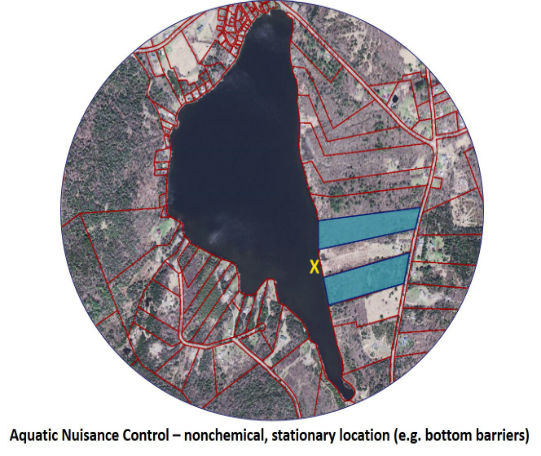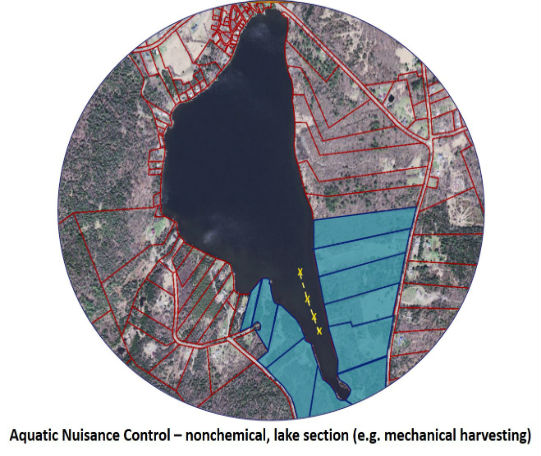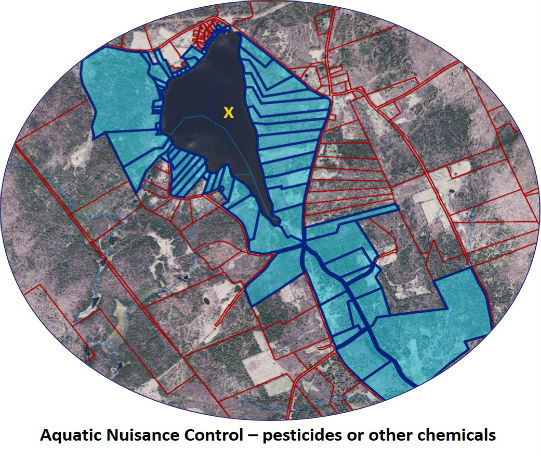You may now submit permit applications, compliance reports and fee payments through our new online form to expedite its receipt and review
Any use of pesticides, chemicals other than pesticides, biological controls, bottom barriers, structural barriers, structural controls, or powered mechanical devices in waters of the State to control an aquatic nuisance requires an Aquatic Nuisance Control (ANC) permit. Jurisdictional waters include all rivers, streams, creeks, brooks, reservoirs, ponds, lakes, and springs and all bodies of surface waters, artificial or natural, that are contained within, flow through, or border upon the State or any portion of it. This includes both public waters and private ponds (please go to the bottom of this page for more information on control projects in private ponds). Private ponds are considered natural ponds not more than 20 acres in size or artificial ponds of any size, which are owned by one person and located entirely on the owner's property (10 V.S.A. § 5210). ANC permits include general permit authorizations and individual permits. Please review the following table and descriptions of each to ensure you are applying with the most appropriate application form. If unsure which application form to use, please contact Olin Reed (olin.reed@vermont.gov (802) 490-6121) before submitting an application.

ANC General Permit
The Aquatic Nuisance Control General Permit (ANCGP) is for individual shoreline property owners to conduct small scale non-chemical control activities adjacent to their shoreline property (e.g., dock/swim space) and for lake associations to conduct small scale non-chemical control activities and/or non-chemical rapid response control activities. Control activities approved by this general permit only includes the use of benthic barriers and/or powered mechanical devices that utilize diver assisted suction harvesting. Control activities may target aquatic plants only. Rapid response control activities may only target new nonindigenous aquatic plant species (e.g., a new infestation of an aquatic invasive species). A lake association must be registered with the Secretary of the Agency of Natural Resources to apply for ANCGP coverage.
For individual shoreline property owners and lake associations to apply for small scale non-chemical aquatic plant control, please complete and submit the following form(s):
Aquatic Nuisance Control Activity Notice of Intent Application
Lake Association Registration Form
For lake associations to apply for non-chemical aquatic plant rapid response control, please complete and submit the following form(s):
Rapid Response Control Activity Registration Application
Lake Association Registration Form
Under 10 V.S.A. Chapter 170, aquatic nuisance control activities require Type 4 notice (minimum 14-day public comment period), and rapid response control activities require Type 5 notice (emergency permits – no public comment period).
The ANCGP expires on April 30, 2028. Aquatic nuisance control activities (e.g., authorized NOI) expire upon the expiration of the ANCGP. Rapid response control activities expire three years from the date that authorization is issued unless an earlier date is specified within the authorization (e.g., upon expiration of the ANCGP).
ANC Individual Permit
Individual permits are for all additional project types that are beyond the scope of what can be approved under the ANCGP (e.g., a municipality or lake association applying to chemically or non-chemically manage an established infestation of an aquatic invasive species). Please complete and submit the appropriate application form based on the proposed project type:
Pesticides
Chemicals other than Pesticides
Bottom barriers
Powered mechanical devices (e.g., mechanical harvesting, diver assisted suction harvesting)
Structural Controls
Biological Controls
Aquatic Nuisance Control Fees
Adjoining Property Owner Notification for ANC Individual Permit Application
Adjoining Property Owner Notification Instructions
***As of January 1, 2018, the State of Vermont requires that applicants applying for an Aquatic Nuisance Control Individual Permit provide notice to adjoining landowners (10 V.S.A. § 7701 et seq)
As a part of submitting an administratively complete Aquatic Nuisance Control Individual Permit application, the applicant and/or their representative must provide notice to adjoining property owners at the same time the application is submitted (10 V.S.A. § 7701 et seq). The applicant must certify on the application that notifying adjoining property owners has been completed prior to application submittal.
Note: Adjoining property owner notification is only applicable to individual permit applications. Notice to adjoining property owners is not required when submitting an application for Aquatic Nuisance Control General Permit coverage.
- If the project is considered large and complex, additional notification requirements apply. Contact Olin Reed (olin.reed@vermont.gov) for additional information. Use the Permit Navigator tool to identify the required environmental permits and approvals for projects on a single parcel. If it is a linear, polygon, or multi-parcel project, contact a Community Assistance Specialist to get started.
- The OFFICIAL NOTICE letter is required to be sent by U.S. Mail to notify an adjoining property owner. Note: Permit application materials are not required to be sent with this notice.
- An Adjoining Property Owner Notice for each type of Aquatic Nuisance Control Individual Permit application is required as identified in the Adjoining Property Owner Notification Instructions and as depicted below:



Addition or Termination of Co-Permittee for Individual Permits
Any individual or entity other than the permittee that is engaging in the permitted jurisdictional activity shall notify the Secretary to obtain co-permittee status prior to any such work. A co-permittee shall be subject to all terms and conditions of the individual permit. Notification of the addition or termination of co-permittee status shall occur using the following form:
Notice of Co-Permittee Status Form
Report Form - Non-Chemical Aquatic Plant Control Projects
Use this form to document non-chemical aquatic plant control projects as required by a permit and/or to document pesticide minimization measures (e.g., handpulling only). Maintain this documentation for your records and submit this to the Lakes and Ponds Program if required.
Individual Permit Duration
By statute, permits for pesticide use or chemicals other than pesticides may be issued for up to five (5) years. Permits for bottom barriers, powered mechanical devices, structural controls, or biological controls may be issued for up to ten (10) years.
Private Ponds
While a control activity in a private pond is still under the jurisdiction of Aquatic Nuisance Control, the use of bottom barriers, structural barriers, structural controls, powered mechanical devices, and copper compounds as an algaecide in waters with a surface area of one acre or less located entirely on a person's property and with an outlet where the flow can be controlled for at least three days is exempt from requiring an ANC permit (10 V.S.A. § 1455(g)). If a copper compound algaecide contains anything more than a copper compound only (e.g., an algaecide that contains a copper compound mixed with other solutions such a bacteria or enzymes), the use of that product would not meet this exemption. Please be aware that this exemption does not relieve one from all other applicable federal, state, and local laws or regulations. For example, if the pond is also a wetland, the control project may also be jurisdictional to the Wetlands Program.
For additional information on the construction, management, and regulations pertaining to private ponds, please visit the Private Ponds webpage.
